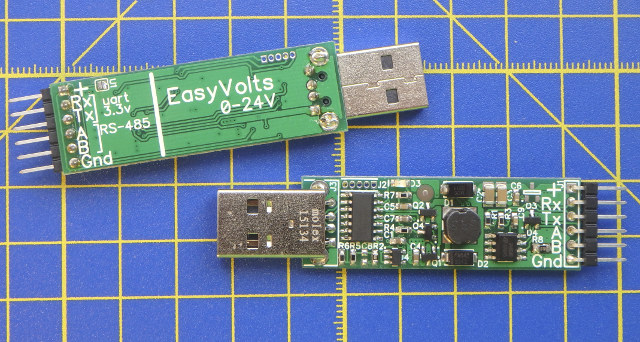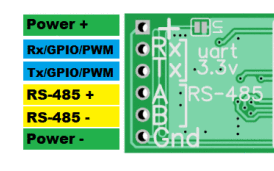A while ago, I wrote about USBminiPower, a USB power supply with 3.3V, 5V, and one variable DC output up to 14.3V adjustable with a rocker switch, and equipped for a 4-digit LED display showing current intensity and voltage.
But recently, I was made aware of another USB power supply – EasyVolts USB dongle – that supports 0 to 24V DC, and also exposes either UART pins, or RS-485 signal, plus two GPIO/PWM pins.
- USB – 1x USB port for power, communication
- Power Supply function:
- Input voltage: 5V from USB port
- Output voltage: 0-24V
- Max output current: 1A
- Max output power: ~2.4W (e.g. 24V/0.1A; 3.3V/0.55A)
- Voltage resolution: <50mV
- Current resolution: <2mA
- I/O expansion

- 4- pin to be used as UART (Tx/Rx) or RS-485 + 2x GPIO/PWM
- UART – speed: 300-230400 bit/sec; resistance of Tx/Rx pins: 300 Ohm
- PWM – Base frequency: 240kHz.; frequency division configuration: 1-65535; duty cycle resolution: 0.5%.
- Logic levels – 3.3V
When the device is connected to USB it appears on PC as two virtual COM ports. One is used to control power supply and GPIO, the second – as “USB-UART/RS485” adapter. This allows you to control the device easily with any software that can communicate over COM port, but to make things easier, the developer – Valerii Proskurin – also wrote EasyVoltGUI program, showcased in the video below to control a servo using PWM signals.
A 0-15V version of EasyVolts (Rev. 1) was first launched on Indiegogo a few months, and I did not exactly work according to plans, as the project did not get funded. But the developer has now released the hardware design files (DipTrace’s schematics & PCB layout, BoM and Gerber) for the first revision of the board, as well as the firmware source code on Github.
The new revision of the board with 0 to 24V support is not available yet, but you can follow progress on EasyVolts website and blog.

Jean-Luc started CNX Software in 2010 as a part-time endeavor, before quitting his job as a software engineering manager, and starting to write daily news, and reviews full time later in 2011.
Support CNX Software! Donate via cryptocurrencies, become a Patron on Patreon, or purchase goods on Amazon or Aliexpress







> display showing intensity
Commonly known as “current” in English.
Not bad at all. While my RC motor days are long behind me, I’d jump all over this if it could get around ~15w so I could replace my bench power supply.
Btw, the github repos have the C code and schematics but I couldn’t find the python script used for the GUI so I can’t be sure, but if you’re using tkinter, you can draw anything from sine waves, saws to pulses fairly easily with canvases and create_line as shown here: https://stackoverflow.com/questions/27397091/how-to-draw-sinus-wave-with-tkinter
@RK
Hi RK,
unfortunately, from USB2.0 we can’t get more than 2.5W, but from USB3.0 we could get at least 7.5W in its basic configuration and maximum up to 100W in USB-C. So maybe in future, there will be more powerful EasyVolts. For UI I used wxWidgets, but at the moment it’s very buggy and dirty code, so I haven’t published it yet. It will be published as soon as there is a stable version. Re drawing on the GUI, do you suggest to make a Voltage/Current graph?
it is great and very handy!
@Kurting
Thank you, Kurting. Hopefully, new EasyVolts with better functionality and lower price will have more success than its predecessor. I did some cost optimizations, so the price of the latest version of EasyVolts will be significantly lower (~30usd). If the interest to the EasyVolts will be large enough I’ll try to repeat crowdfunding campaign.